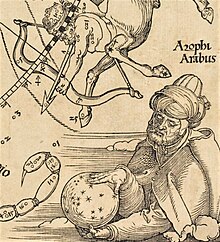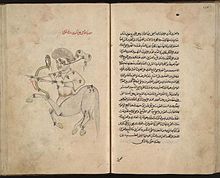Abd al-Rahman al-Sufi
ʿAbd al-Raḥmān al-Ṣūfī | |
|---|---|
عبدالرحمن الصوفي | |
 Al-Ṣūfī, as depicted inAlbrecht Dürer'swoodcutImagines coeli septentrionales cum duodecim imaginibus zodiaci [The Northern Celestial Hemisphere with the Twelve Signs of the Zodiac](1515) | |
| Born | December 7, 903 |
| Died | May 25, 986(aged 82) |
| Occupation(s) | Astronomer,mathematician |
| Era | Islamic Golden Age |
| Notable work | Kitāb ṣuwar al-kawākib( "The Book of Fixed Stars") |
ʿAbd al-Raḥmān al-Ṣūfī(Persian:عبدالرحمن الصوفی;7 December 903 – 25 May 986) was a Persian Muslimastronomer.[1][2]His workKitāb ṣuwar al-kawākib( "The Book of Fixed Stars"), written in 964, included both textual descriptions and illustrations. The PersianpolymathAl-Biruniwrote that al-Ṣūfī's work on theeclipticwas carried out inShiraz.Al-Ṣūfī lived at theBuyidcourt inIsfahan.
Biography
[edit]ʿAbd al-Rahmān al-Ṣūfī (full name: Abū’l-Ḥusayn ʿAbd al-Raḥmān ibn ʿUmar ibn Sahl al-Ṣūfī al-Rāzī)[3]was one of the nine famous Muslim astronomers.[citation needed]He lived at the court ofEmir'Adud al-DawlainIsfahan,and worked on translating and expandingancient Greek astronomical works,especially theAlmagestofPtolemy.He made corrections to Ptolemy's star list, and his estimations of starbrightnessandmagnitudedeviated from those by Ptolemy; just over half of al-Ṣūfī's magnitudes being identical to Ptolemy's.[4]A Persian, al-Ṣūfī wrote inArabic,thelingua francaof the scientific Muslim world.[5]
Al-Ṣūfī was a major contributor to the translation into Arabic of theHellenisticastronomy that had been centered inAlexandria,Egypt.His was the first to attempt to relate theGreekwith the traditionalArabicstar names andconstellations,which were completely unrelated and overlapped in complicated ways.[citation needed]
Astronomy
[edit]Al-Ṣūfī made his astronomical observations at a latitude of 32.7N° in Isfahan.[4]It has been claimed that he identified theLarge Magellanic Cloud,[citation needed]but this seems to be a misunderstanding of a reference to some stars south of Canopus which he admits he has not seen.[6]He also made the earliest recorded observation of theAndromeda Galaxyin 964, describing it as a "small cloud".[7]This was the firstgalaxyother than theMilky Wayto be mentioned in writing.[8]
Astrolabe
[edit]Al-Ṣūfī also wrote about theastrolabe,finding numerous additional uses for it: According to American Near Eastern scholar Adam L. Bean, Al-Ṣūfī's work reportedly described over 1000 different uses in areas as diverse asastronomy,astrology, horoscopes,navigation,surveying,timekeeping,QiblaandSalatprayer.[9][10]
Kitāb ṣuwar al-kawākib( "The Book of Fixed Stars")
[edit]
Al-Ṣūfī publishedKitāb ṣuwar al-kawākib( "The Book of Fixed Stars") in 964, and dedicated it to Adud al-Dawla, the ruler ofBuwayhidat the time.[6]This book describes 48 constellations and the stars within them.[citation needed]
Al-Ṣūfī compared Greek constellations and stars as described inPtolemy’sAlmagestwith Arabic ones,[12]linking those that were the same.[13][page needed]He included two illustrations of each constellation, one showing the orientation of the stars from the perspective outside thecelestial globe,and the other from the perspective of looking at the sky while standing on the Earth. He separated them into three groups; 21 seen from the north, 15 seen from the south, and the 12zodiacconstellations. He included a complete set ofstar charts,that included the names and numbers of the individual stars in each of the 48 constellations, and each star'slongitudinal and latitudinal coordinates,magnitude,and location north or south of theecliptic.[6]
Scribalerrors within the 35 surviving copies ofThe Book of Fixed Starshave caused the value of the magnitude for a particular star to vary from manuscript to manuscript.[14][page needed][15]Al-Ṣūfī organized the stars in each of his drawings into two groups: those that form the image depicted, and others that are in close proximity to the image. He identified and described stars not included by Ptolemy, but he did not include them in his own star charts. Stating that his charts were modelled after Ptolemy, he left the stars excluded in Ptolemy's catalogue out of his charts as well.[6]
To allow for the longitudinal placement of the stars within constellations having changed over the eight centuries since theAlmagestwas written, Al-Ṣūfī added 12° 42' to all the longitudes values provided by Ptolemy.[16]Al-Ṣūfī differed from Ptolemy by having a three level scale to measure the magnitude of stars instead of a two level scale. This extra level increased the precision of his measurements. His methodology for determining these magnitude measurements cannot be found in any of his extant texts.[4]
Despite the importance ofThe Book of Fixed Starsin thehistory of astronomy,it took more than 1000 years until the first partial English translation of the book was published in 2010.[17][better source needed]
Legacy
[edit]
Al-Ṣūfī's astronomical work was subsequently used by many other astronomers, includingUlugh Begwho was both a prince and astronomer.[6]
Thelunar crater Azophiand the minor planet12621 Alsufiare named after Al-Ṣūfī.[citation needed]
The Astronomy Society of Iran – Amateur Committee has held internationalSufi Observing Competitionsin memory of the astronomer. The first competition was held in 2006 in the north ofSemnanProvince,[18]and the second was held in the summer of 2008 inLadiznear theZahedan.More than 100 attendees from Iran and Iraq participated in these events.[19]
Google Doodlecommemorated Al-Ṣūfī's 1113th birthday on 7 December, 2016.[20]
See also
[edit]Notes
[edit]References
[edit]- ^Al-Qifti.Ikhbār al-ʿulamāʾ bi-akhbār al-ḥukamāʾ( "History of Learned Men"). In:ʿAbd al-Raḥmān al-Ṣūfī and his Book of the Fixed Stars: A Journey of Re-discoveryby Ihsan Hafez, Richard F. Stephenson, Wayne Orchiston (2011). In: Orchiston, Wayne,Highlighting the history of astronomy in the Asia-Pacific region: proceedings of the ICOA-6 conference. Astrophysics and Space Science Proceedings.New York: Springer.ISBN978-1-4419-8161-5."…is the honored, the perfect, the most intelligent and the friend of the King Adud al-Dawla Fanakhasru Shahenshah ibn Buwayh. He is the author of the most honored books in the science of astronomy. He was originally from Nisa and is of a Persian descent."
- ^van Gent, Robert Harry."Biography of al-Sūfī".University of Utrecht.Retrieved11 January2014.
- ^Kunitzsch1988.
- ^abcSchaefer 2013.
- ^Selin 1997,p. 160.
- ^abcdeHafez, Stephenson & Orchiston 2011.
- ^Ridpath.
- ^"Andromeda Galaxy".Britannia.Retrieved13 January2023.
- ^Bean, Adam L. (2009)."Astrolabes".InBirx, H. James(ed.).Encyclopedia of Time: Science, Philosophy, Theology, & Culture.SAGE.p. 59.ISBN978-1-4129-4164-8.
- ^Winterburn, Emily (2005)."Using an Astrolabe".Muslim Heritage.Foundation for Science, Technology and Civilisation, UK (FSTCUK).Retrieved22 January2008.
- ^Atbaş, Zeynep (1 August 2019).Artistic Aspects of Sultan Bayezid II's Book Treasury Collection: Extant Volumes Preserved at the Topkapı Palace Museum Library (Treasures of Knowledge: An Inventory of the Ottoman Palace Library (1502/3-1503/4) (2 vols)).Brill. pp. 161–211.doi:10.1163/9789004402508_005.
- ^Atbaş, Zeynep (1 August 2019).Artistic Aspects of Sultan Bayezid II's Book Treasury Collection: Extant Volumes Preserved at the Topkapı Palace Museum Library (Treasures of Knowledge: An Inventory of the Ottoman Palace Library (1502/3-1503/4) (2 vols)).Brill. p. 195.doi:10.1163/9789004402508_005.
- ^Cavin 2011.
- ^Orchiston, Green & Strom 2014.
- ^Knobel 1885.
- ^Upton 1933.
- ^Hafez, Ihsan (October 2010).ʿAbd al-Raḥmān al-Ṣūfī and his book of the fixed stars: a journey of re-discovery.James Cook University(phd). pp. 2–4.
- ^"A night full of memories; the first Sufi competition".Nojum Magazine. Archived fromthe originalon 20 October 2009.Retrieved7 January2009.
- ^رقابت صوفي، درآمدي بر سال جهاني نجوم[Sufi competition, an income for the International Year of Astronomy]
- ^"Abd al-Rahman Al-Sufi's (Azophi) 1113th Birthday".7 December 2016.
Bibliography
[edit]- Al-Qifti.Ikhbār al-ʿulamāʾ bi-akhbār al-ḥukamāʾ(History of Learned Men). In:ʿAbd al-Raḥmān al-Şūfī and his Book of the Fixed Stars: A Journey of Re-discoveryby Ihsan Hafez, Richard F. Stephenson, Wayne Orchiston (2011). In: Orchiston, Wayne,Highlighting the history of astronomy in the Asia-Pacific region: proceedings of the ICOA-6 conference. Astrophysics and Space Science Proceedings.New York: Springer.ISBN978-1-4419-8161-5."…is the honored, the perfect, the most intelligent and the friend of the King Adud al-Dawla Fanakhasru Shahenshah Ibn Buwaih. He is the author of the most honored books in the science of astronomy. He was originally from Nisa and is of a Persian descent."
- Cavin, Jerry D. (2011).The Amateur Astronomer's Guide to the Deep-Sky Catalogs.Springer Nature.ISBN978-1-4614-0656-3.
- Hafez, Ihsan; Stephenson, Richard; Orchiston, Wayne (2011). "Abd al-Rahman al-Sufi and his Book of the Fixed Stars". In Orchiston, Wayne; Nakamura, Tsuko; Strom, Richard G. (eds.).Highlighting the History of Astronomy in the Asia-Pacific Region.Springer Nature.pp. 121–138.ISBN978-14419-8-161-5.
- Kepple, George Robert; Sanner, Glen W. (1998).The Night Sky Observer's Guide.Vol. 1. Willmann-Bell.ISBN0-943396-58-1.
- Knobel, E. B. (1885)."On Al Sufi's star magnitudes".Monthly Notices of the Royal Astronomical Society.45(8).Royal Astronomical Society:417–425.Bibcode:1885MNRAS..45..417K.doi:10.1093/mnras/45.8.417.
- Kunitzsch, P. (1988)."ʿAbd-al-Raḥmān b. ʿOmar Ṣūfī".Encyclopædia Iranica.
- Orchiston, Wayne; Green, David A.; Strom, Richard, eds. (2014).New Insights From Recent Studies in Historical Astronomy: Following in the Footsteps of F. Richard Stephenson: A Meeting to Honor F. Richard Stephenson on His 70th Birthday.Springer Nature.ISBN978-3-319-07614-0.
- Ridpath, Ian."Star Tales: al-Şūfī's nebulae".
- Russell, G.A., ed. (1994).The 'Arabik' Interest of the Natural Philosophers in Seventeenth Century England.Brill's Studies in Intellectual History. Leiden; New York; Cologne: E.J. Brill.ISBN9004098887.
- Schaefer, Bradley E. (2013). "The Thousand Star Magnitudes in the Catalogues of Ptolemy, Al Sufi, and Tycho are All Corrected for Atmospheric Extinction".Journal for the History of Astronomy.44(1): 47–A91.arXiv:1303.1833.Bibcode:2013JHA....44...47S.doi:10.1177/002182861304400103.ISSN0021-8286.S2CID119202231.
- Selin, Helaine (1997).Encyclopaedia of the History of Science, Technology, and Medicine in Non-Western Cultures.Berlin; New York:Springer Nature.ISBN978-1-4020-4960-6.
- Upton, Joseph M. (1933). "A Manuscript of" The Book of the Fixed Stars "by ʿAbd Ar-Raḥmān Aṣ-Ṣūfī".Metropolitan Museum Studies.4(2): 179–197.doi:10.2307/1522800.JSTOR1522800.
External links
[edit]- Abd ar-Rahman as-Sufi (903-986): Liber locis stellarum fixarum, 964- illustrations from copies ofThe Book of Fixed Stars,and information and links relating to the work (self-published, in Italian)
- Liber locis stellarum fixarum, 964, manoscritto del 1417 riprodotto il 1730 da atlascoelestis
- Ulug Beg in atlascoelestis
- Al-Sufi's constellations
- Al-Sūfī’s Book of the Constellations of the Fixed Stars and its Influence on Islamic and Western Celestial Cartography– with comprehensive bibliography and list of known manuscripts.
